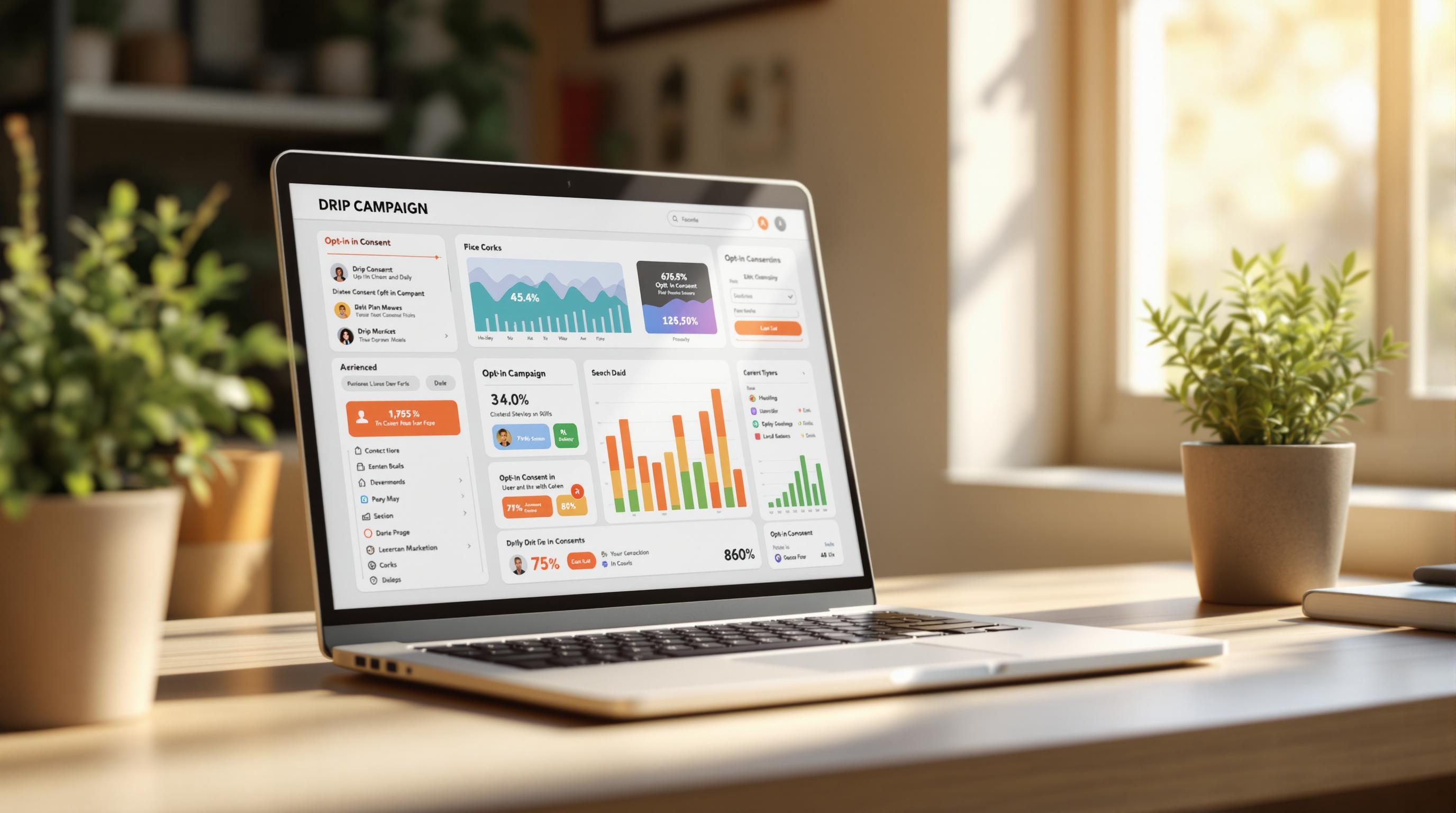Time decay attribution helps you understand how recent marketing touchpoints contribute more to conversions compared to earlier ones. This model assigns higher credit to interactions closer to the conversion event, making it ideal for analyzing long sales cycles or multi-channel campaigns. Unlike first-touch, last-touch, or linear attribution models, it balances the influence of all touchpoints while prioritizing recency.
Key Steps to Implement in Python:
- Organize your data with fields like customer ID, touchpoint dates, and conversion values.
- Use the exponential decay formula (weight = e^(-λt)) to calculate weights for touchpoints based on their timing.
- Normalize weights so they sum up to 1 for each customer journey.
- Combine weights with conversion values to attribute credit to specific channels.
Python libraries like pandas and numpy simplify the process, while tools like matplotlib help visualize results. This approach offers a structured way to evaluate marketing performance and optimize resource allocation. Start by cleaning your data, defining a decay rate, and iterating based on insights from your analysis.
Attribution Modelling and Budget Optimisation
Data Preparation and Requirements for Python Implementation
Before diving into Python, make sure your marketing data is well-organized. A structured dataset is the backbone of any reliable time decay attribution model.
Key Data Fields and Structure
You'll need a unique identifier - such as a Customer ID, Session ID, or Journey ID - to group all interactions by customer. This identifier is crucial for analyzing customer behavior and serves as the foundation for your attribution analysis.
Additionally, ensure your data is clean and properly formatted. Tools like Pandas can help streamline this process, making it easier to prepare your data for model implementation.
Building the Time Decay Attribution Model in Python
With your data cleaned and organized, it’s time to dive into building the time decay attribution model. This involves understanding the math behind it, coding it step-by-step, and efficiently managing multiple datasets.
Mathematical Basis: Decay Function
At the heart of time decay attribution lies the exponential decay function. This method prioritizes touchpoints closer to the conversion event, giving them more credit, while earlier interactions are weighted less.
Here’s the formula: weight = e^(-λt). In this equation, λ (lambda) is the decay rate, and t represents the time gap between the touchpoint and the conversion. A higher λ results in a steeper decay, favoring recent interactions, while a lower λ spreads the credit more evenly across the customer journey.
The choice of λ depends on your business. E-commerce businesses, where decisions are made quickly, often go for higher decay rates. On the other hand, B2B companies, with longer sales cycles, usually prefer slower decay rates. Regardless of the rate, the function ensures that all touchpoint weights add up to 1.0, providing a clear and logical representation of customer behavior.
Now, let’s implement this step-by-step in Python.
Step-by-Step Python Implementation
First, import the necessary libraries and load your dataset. You’ll need pandas for data handling, numpy for calculations, and datetime for working with dates.
import pandas as pd
import numpy as np
from datetime import datetime, timedelta
# Load your cleaned dataset
df = pd.read_csv('marketing_touchpoints.csv')
df['touchpoint_date'] = pd.to_datetime(df['touchpoint_date'])
df['conversion_date'] = pd.to_datetime(df['conversion_date'])
Next, calculate the days before conversion for each touchpoint. This creates the time variable needed for the decay function:
df['days_before_conversion'] = (df['conversion_date'] - df['touchpoint_date']).dt.days
Now, apply the exponential decay formula. Set your λ value based on your business needs - 0.1 is a common starting point:
lambda_decay = 0.1
df['raw_weight'] = np.exp(-lambda_decay * df['days_before_conversion'])
Normalize the weights so that the total for each customer journey equals 1.0:
df['attribution_weight'] = df.groupby('customer_id')['raw_weight'].transform(
lambda x: x / x.sum()
)
Finally, calculate the attributed conversion value by multiplying the conversion value by the weight:
df['attributed_value'] = df['conversion_value'] * df['attribution_weight']
To see the results by marketing channel, aggregate the data:
channel_attribution = df.groupby('channel').agg({
'attributed_value': 'sum',
'attribution_weight': 'sum'
}).round(2)
Handling Multiple Datasets or Campaigns
If you’re working with multiple datasets, Python’s generator functions can help you process them efficiently without overloading memory.
"If working with data from multiple clients or campaigns, structure the process to loop through datasets efficiently. A Python generator function is a good choice for this. Combine the processed results into a final summary dataset using concatenation functions like pd.concat() for visualization and reporting." – Richa Bhardwaj, Author, DigGrowth
Here’s how you can create a generator function to process each campaign:
def process_campaigns(campaign_list, lambda_decay=0.1):
for campaign_file in campaign_list:
# Load and process each campaign
df = pd.read_csv(campaign_file)
df['touchpoint_date'] = pd.to_datetime(df['touchpoint_date'])
df['conversion_date'] = pd.to_datetime(df['conversion_date'])
# Apply time decay attribution
df['days_before_conversion'] = (df['conversion_date'] - df['touchpoint_date']).dt.days
df['raw_weight'] = np.exp(-lambda_decay * df['days_before_conversion'])
df['attribution_weight'] = df.groupby('customer_id')['raw_weight'].transform(
lambda x: x / x.sum()
)
df['attributed_value'] = df['conversion_value'] * df['attribution_weight']
yield df
Combine the processed datasets using pandas.concat() for a unified view:
campaign_files = ['campaign_1.csv', 'campaign_2.csv', 'campaign_3.csv']
processed_campaigns = list(process_campaigns(campaign_files))
# Combine with campaign identifiers
final_results = pd.concat(
processed_campaigns,
keys=['Campaign_1', 'Campaign_2', 'Campaign_3'],
ignore_index=True
)
This method allows you to efficiently handle multiple campaigns, whether it’s a handful or hundreds. By using the keys parameter in pd.concat(), you can keep track of which data belongs to which campaign. Setting ignore_index=True ensures the final dataset has a clean, sequential index.
For scalability, consider storing the processed data in a database and automating the workflow using scheduling tools. This way, you can manage large datasets and regularly update your attribution analysis without manual intervention.
sbb-itb-a84ebc4
Evaluating and Interpreting Model Results
Once your model is up and running, the next step is to dig into the results and see how credit allocation sheds light on your marketing performance. After implementing the decay function in Python, the real value lies in analyzing the outputs to uncover actionable insights.
Understanding Credit Distribution
Time decay attribution assigns weight to each touchpoint based on its recency, meaning interactions closer to the conversion get more credit. However, earlier touchpoints aren’t overlooked - they play a pivotal role in building awareness and trust, which are essential for eventual conversions. Just because an early interaction has a lower individual weight doesn’t mean it’s less important. This approach gives you a more nuanced understanding of how every phase of the customer journey contributes to the bigger picture.
Comparing Attribution Models
Attribution models can tell very different stories about how your marketing channels contribute to conversions. Time decay attribution, for example, strikes a balance by recognizing the importance of early interactions that spark interest and later ones that seal the deal. Comparing models can uncover variations in metrics like customer lifetime value, emphasizing that even channels with smaller immediate credit can have a significant impact on long-term profitability. Seasonal trends and the timing of campaigns add another layer to these insights, showing how dynamic the customer journey can be.
Application for ROI Optimization
Armed with these insights, you can refine your budget and campaign strategies. If a channel’s contribution doesn’t match its share of the budget, it might be time to reallocate resources to maximize ROI. Similarly, aligning campaigns with periods when attribution weights are higher can improve performance. Tailoring creative messaging to different stages of the customer journey and understanding how channels complement each other can lead to more cohesive and effective campaigns. By benchmarking performance with an eye on each channel’s role in the extended journey, you can set realistic goals and continuously improve through testing and learning from attribution-driven strategies.
Practical Tips, Scalability, and Resources
Let’s dive into some practical advice, scalable strategies, and handy resources to help you bridge the gap between theory and execution.
Optimization and Scalability Tips
When transitioning from a prototype to a full-scale production environment, one effective strategy is to precompute decay weights. This approach can significantly improve efficiency and reduce computational overhead.
Resources for Marketers
To go beyond basic optimization, take advantage of tools and libraries designed for deeper attribution analysis. Python’s ecosystem is well-equipped for this purpose:
- NumPy and SciPy: Perfect for handling decay functions.
- pandas: Ideal for data manipulation and cleaning.
- matplotlib and seaborn: Great for creating visualizations that clearly convey attribution insights.
For those looking to push the boundaries, combining time decay methods with machine learning algorithms can lead to more dynamic and precise attribution models. For instance, you can use scikit-learn to integrate machine learning into your analysis. To get practical examples and advice, engage with developer communities on Stack Overflow and GitHub.
Another invaluable resource is the Marketing Funnels Directory (https://topmarketingfunnels.com). This site offers a curated collection of tools, vendors, courses, and books tailored to attribution modeling and funnel optimization. It covers a variety of topics, including social media attribution, paid advertising analysis, content marketing measurement, and B2B funnel strategies. These resources can help marketers refine their approaches and achieve better results.
US-Specific Implementation Considerations
When implementing these strategies in the US market, keep these localization details in mind:
- Currency Formatting: Use the format
$1,234.56by leveraging Python’slocalemodule. - Date Representation: Follow the MM/DD/YYYY format (e.g.,
strftime('%m/%d/%Y')in Python). - Time Zones: Standardize timestamps to UTC with Python's
pytzlibrary before converting them to local time. - Privacy Standards: Ensure compliance with US regulations like the California Consumer Privacy Act (CCPA). This includes clear data retention policies and anonymization protocols to protect user privacy.
Conclusion
Time decay attribution offers a refined way to understand how recent interactions influence conversions, improving upon traditional models. As outlined earlier, this approach tailors decay functions and manages multi-channel datasets to shed light on the role of each touchpoint. By implementing this model in Python, you can unlock actionable insights that lead to smarter marketing strategies.
Key Takeaways on Time Decay Attribution
The core principle of time decay attribution lies in its ability to provide a balanced view of customer journeys. Unlike first-touch or last-touch models that oversimplify the process, time decay recognizes that touchpoints closer to the conversion are often more impactful, while still valuing earlier interactions. This makes it especially useful for businesses with longer sales cycles or customer journeys involving multiple channels.
Leveraging Python libraries like pandas, NumPy, and visualization tools, combined with strict attention to data quality, ensures reliable and scalable results. Precomputing decay weights further enhances performance, making this approach adaptable as your business scales.
Additionally, maintaining compliance with U.S. privacy standards, such as CCPA, is essential. Adhering to these guidelines protects your organization while allowing you to continue deriving valuable insights from your data.
Next Steps
Now that you’re equipped with these insights, start by auditing your data infrastructure to assess touchpoint quality and identify any gaps in tracking. Begin with a straightforward implementation based on the mathematical principles discussed here, gradually adding more advanced features as you gain confidence.
For further support, check out the Marketing Funnels Directory (https://topmarketingfunnels.com). This resource offers a curated selection of attribution tools, educational materials, and vendor solutions to help you refine your approach and explore new ways to optimize your marketing funnel.
Experimentation is key. Test various decay functions, compare results across different time frames, and evaluate your findings against real business outcomes. The flexibility of Python allows you to tweak parameters and explore new methods as your understanding of your customer journey evolves.
Finally, remember that attribution modeling is a continuous process. As marketing channels and customer behaviors change, your model should evolve too. The work you put in now lays the groundwork for deeper analyses and improved marketing ROI in the future.
FAQs
How can I choose the right decay rate (λ) for my time decay attribution model?
In a time decay attribution model, the decay rate (λ) plays a crucial role in determining how quickly a touchpoint's influence diminishes over time. The right λ value depends on factors like your business's sales cycle and how customers typically engage with your brand.
To get started, choose a value between 0 and 1 - many begin with 0.5 or 0.8. A higher λ means the influence of a touchpoint lasts longer, while a lower λ causes it to fade more quickly. Experiment with different values and compare them to your actual conversion data to pinpoint the rate that best mirrors your customer journey and aligns with your sales process.
What makes time decay attribution a better choice compared to first-touch or last-touch models?
Time decay attribution is unique in that it assigns more weight to interactions occurring closer to the conversion. This approach highlights how recent touchpoints play a pivotal role in influencing a customer’s decision, making it especially helpful for pinpointing which late-stage marketing efforts lead to results.
Unlike first-touch or last-touch models that focus solely on one interaction, time decay takes the entire customer journey into account. By prioritizing recent engagements, it offers a more well-rounded view of how various touchpoints contribute to conversions, enabling marketers to fine-tune their campaigns with greater precision.
Can I use machine learning with time decay attribution to improve my marketing insights?
Yes, you can pair machine learning with time decay attribution to dig deeper into your marketing performance and even predict future trends. Machine learning algorithms - like generalized linear models or Bayesian networks - are great at sifting through large datasets to spot patterns in customer behavior and refine attribution accuracy.
By incorporating these models into your attribution framework with tools like Python libraries, you can adapt your strategies dynamically based on real-time data. This method not only highlights your most effective marketing channels but also fine-tunes campaigns to boost ROI. To make it work, you'll need to prepare your data properly, create meaningful features, and choose algorithms that align with your specific goals.


